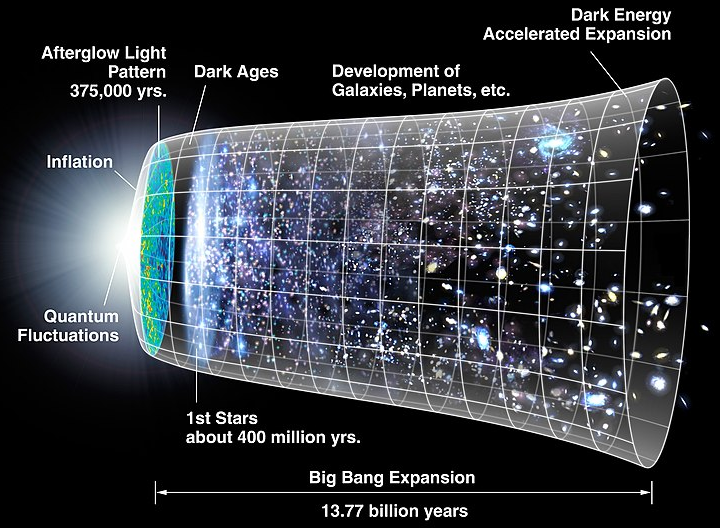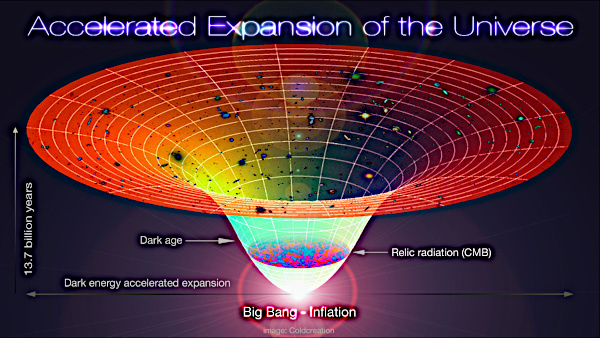
Image: Oblong representation of the evolution of the universe over 13.77 billion years (3D expansion on a flat plane). The far left represents the first moment of the Universe before its exponential growth in all directions. Its size is represented by the vertical extent of the grid in this graph.
This 3D representation on a flat plane shows the expansion of the observable Universe, which is not perfect. In reality, it is more like a sphere, with us at the center.
Image credit: Wikimedia Commons (Public domain).
13.77 billion years ago a tremendous explosion called the Big Bang gave birth to space, time and matter. In this unimaginably hot chaos, a bubble will swell, expand in all directions and slowly cool.
The term "Big Bang" was coined in the 1950s by the English astrophysicist Fred Hoyle (1915-2001) to ironically designate the concept of "original explosion". This cosmological model was developed in the 1920s by the Belgian astrophysicist Georges Lemaître (1894-1966) and the Russian physicist Alexander Friedmann (1888-1925).
The history of the Big Bang does not prejudge the existence of an "initial moment" or a beginning.
However, even today, we can still detect a trace of this origin in the sky, which we call “fossil radiation”. This radiation is microwave radiation at low temperature, of the order of 3 K. This radiation reaches us from all directions of the cosmos. It is so called because it forms a background to all the point radio sources that have been detected by radio telescopes.
The Big Bang was detected in 1965 by Arno Allan Penzias (1933-2024) and Robert Woodrow Wilson (1936-). They were awarded the Nobel Prize in Physics in 1978.
In the beginning there is nothing, no matter, no void, time and space do not exist. From a point smaller than an atom, infinite energy will create the universe.
It all begins a tiny fraction of a second after the original explosion, the Big Bang. Time begins to unfold, the entire cosmos will take shape at once. It's the greatest mystery of all time.
Before this period, we know nothing, there is no time zero, time does not exist, we have no data to say that there is something. For scientists, the cosmic clock strikes its first stroke at 10^-43 seconds (Planck time). The universe is a bubbling void of very dense energy that is incredibly hot, then we suppose, it suddenly swells, this is inflation. At 10^-32 seconds, the first elements of matter accompanied by antimatter emerge (elementary particles and antiparticles).
Then, the strong nuclear force, at a time of 10^-6 seconds, that is to say 1 millionth of a second, will assemble the quarks, 3 by 3 to give protons and neutrons and form the nuclei (hydrogen, helium ).
At 3 minutes, 98% of the mass of the universe is made up. Nothing new until 380,000 years ago, the end of the radiative era.
Then begins the material era and appears the second force, the electromagnetic force. It builds hydrogen and helium atoms by combining electrons with nuclei. The ever-expanding and cooling Universe sees the gravitational force grouping atoms into more complex structures. It is the birth of galaxies and stars.
According to the theoretical model of the Big Bang, fossil microwave radiation is a residue of the energy reigning at the time of the formation of the first stable atoms in the Universe. Radiation becomes matter. This takes place approximately 380,000 years after the primordial explosion. Data from the COBE (Cosmic Background Explorer) satellite showed that this radiation is not as uniform as scientists believed. Areas of varying intensity appear arbitrarily. These fluctuations in density of the primordial Universe would be at the origin of the formation of galaxies.

Image: Representation of the observable Universe in the form of slices of 2D space. This representation is false because since the Big Bang the Universe has expanded in all directions.
Image credit: By Design Alex Mittelmann, Coldcreation, CC BY -SA 3.0, Link.
The observable Universe is represented here by a stack of 2-dimensional slices, each representing the image of the Universe in the past (like images from a film). The last circle at the top, the largest, represents the universe today. The diameters of the circles represent the size of the Universe which decreases as we go back in time.
But in reality the Universe extends in all directions. We must therefore replace each slice, that is to say each circle, by a sphere. We would thus have, not a stack of circles in 2 dimensions but a stack of spheres in 3 dimensions, which is impossible for our brain to imagine.
In this imperfect representation, we are like all the galaxies in the universe on the last circle. Because of the expansion of the Universe, everything seems to be moving away from us, no matter which direction we look. It's like standing on the surface of a balloon and watching it inflate.
We cannot see beyond the circle that is our horizon, because light has a finite speed. Light from objects beyond this "cosmic horizon" has not had enough time to reach us since the Big Bang.
The "balloon" inflates but the horizon does not move away, so the galaxies close to the horizon end up disappearing.
Beyond the observable universe, there are probably infinitely many galaxies, which we cannot see. It is even possible that there are infinite universes!